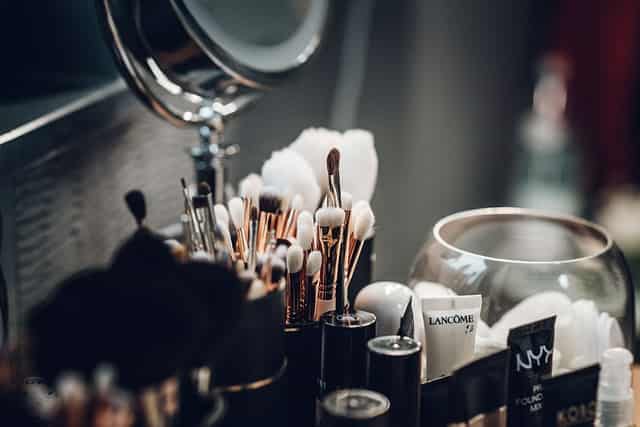Makeup brushes are essential tools for achieving flawless makeup looks, but they can quickly accumulate makeup residue, oils, and bacteria with regular use.
Properly cleaning your makeup brushes is crucial not only for maintaining their longevity but also for promoting healthy skin. There are various methods for cleaning makeup brushes, and one commonly asked question is whether makeup remover can be used for this purpose.
In this article, we will explore the potential benefits and drawbacks of using makeup remover to clean makeup brushes.
So, let’s dive in and find out if this is a safe and effective method.
What is Makeup Remover?
Before we delve into the cleaning aspect, let’s clarify what makeup remover is. Makeup remover is a specialized product designed to dissolve and remove makeup from the skin’s surface.
It is formulated to break down various types of makeup, such as foundation, mascara, eyeliner, and lipstick, making it easier to wipe away with a cloth or cotton pad.
Makeup removers come in different forms, including liquid, wipes, balms, and oils.
Importance of Cleaning Makeup Brushes
Cleaning your makeup brushes regularly is essential for several reasons:
- Maintaining Brush Performance: Makeup brushes that are caked with old makeup and debris can become less effective, resulting in patchy makeup application.
- Preventing Bacterial Buildup: Dirty brushes become breeding grounds for bacteria, which can lead to skin irritations, breakouts, and infections.
- Avoiding Color Contamination: When you use the same brush for different colored makeup products without cleaning in between, it can affect the true colors of the products.
- Extending Brush Lifespan: Proper cleaning can prolong the life of your brushes, saving you money on replacements.
- Enhancing Skin Health: Regularly cleaned brushes ensure that you’re not applying old makeup, dirt, and oils back onto your skin, promoting better skin health.
Can You Use Makeup Remover to Clean Makeup Brushes?
The answer to whether you can use makeup remover to clean your brushes is a bit nuanced. While it can be done and is better than not cleaning them at all, it might not be the most effective or practical method.
The Pros and Cons of Using Makeup Remover for Brush Cleaning
Pros:
- Convenience: If you have makeup remover readily available, it can be a quick and accessible option for cleaning brushes.
- Removes Surface Makeup: Makeup remover can effectively remove the top layer of makeup from the bristles, improving the brush’s appearance.
- Moisturizing Effect: Some makeup removers contain moisturizing ingredients that can condition the brush bristles.
Cons:
- Incomplete Cleaning: Makeup remover may not fully remove all makeup residues, especially deep within the brush bristles.
- A Buildup of Residue: The residue from makeup remover can accumulate in brushes over time, leading to a gunky and unhygienic mess.
- Potential Damage: Prolonged use of makeup remover can dry out brush bristles or damage their adhesive, leading to shedding and reduced brush performance.
- Costly: Continuously using a makeup remover for brush cleaning can be expensive, as these products are primarily designed for skin, not brush cleaning.
To provide a more balanced perspective, let’s explore alternative methods for cleaning makeup brushes that might be more effective and economical.
Alternative Methods for Cleaning Makeup Brushes
Using Gentle Soap and Water
One of the most common and effective methods for cleaning makeup brushes is using a gentle soap and water solution.
- Gather Your Supplies: You will need a gentle shampoo or baby soap and a clean bowl.
- Prep Your Brushes: Rinse the brushes under lukewarm water to remove any superficial makeup.
- Create the Solution: Mix a small amount of shampoo or baby soap with water in the bowl.
- Cleanse the Brushes: Swirl the brushes in the solution and gently massage the bristles to dislodge makeup.
- Rinse and Dry: Rinse the brushes thoroughly under running water until the water runs clear. Gently squeeze out excess water and reshape the bristles. Lay the brushes flat on a clean towel to dry.
Using a gentle soap is usually more cost-effective than makeup removers, and it offers a thorough clean without the risk of damaging the brushes.
DIY Brush Cleaner
Another budget-friendly and effective option is creating your own DIY brush cleaner.
- Mix Vinegar and Water: Create a solution by mixing equal parts of white vinegar and water in a container.
- Dip and Swirl: Dip the brushes into the solution and swirl them around to dislodge makeup.
- Rinse and Dry: Rinse the brushes thoroughly under running water and let them air dry.
This DIY solution is excellent for disinfecting brushes and removing stubborn makeup residue.
Another natural ingredient you can use for cleaning makeup brushes is baking soda. Read How to Clean Makeup Brushes with Baking Soda.
Brush Cleaning Sprays
Brush cleaning sprays are specially formulated to cleanse and disinfect brushes quickly.
- Spray the Solution: Hold the brush cleaning spray a few inches away from the brushes and spritz the bristles.
- Wipe and Dry: Wipe the brushes on a clean cloth or paper towel until they are clean and let them air-dry.
Brush cleaning sprays offer convenience and are ideal for spot-cleaning brushes between uses.
Step-by-Step Guide: How to Clean Makeup Brushes with Makeup Remover
If you still prefer using a makeup remover for brush cleaning, here’s a step-by-step guide to help you do it effectively.
Gather Your Supplies
Before you begin, make sure you have the following:
- Clean cloth or paper towel
- Makeup remover of your choice
- A small bowl or container
Prep Your Brushes
Start by rinsing your makeup brushes under lukewarm water to remove any excess makeup from the bristles.
Dampen a Cloth or Paper Towel
Take a clean cloth or paper towel and dampen it with water. Squeeze out any excess water so that it’s slightly damp but not dripping.
Apply Makeup Remover
Pour a small amount of makeup remover into a container or directly onto the damp cloth or paper towel.
Gently Cleanse the Brushes
Take one makeup brush at a time and swirl the bristles on the damp cloth or paper towel with the makeup remover. Gently press and move the brush in circular motions to dislodge the makeup from the bristles.
Rinse and Dry
Once you’ve removed most of the makeup, rinse the brush under lukewarm water to wash away the makeup remover and any remaining residue. Gently squeeze the bristles to remove excess water.
Finally, reshape the bristles with your fingers and lay the brushes flat on a clean towel to air-dry completely. Avoid drying them upright as water can seep into the brush handle and loosen the glue holding the bristles.
Tips for Proper Makeup Brush Maintenance
Here are some additional tips to help you maintain your makeup brushes in excellent condition:
- Clean Regularly: Aim to clean your makeup brushes at least once a week, especially if you use them frequently.
- Be Gentle: When cleaning the brushes, be gentle with the bristles to avoid damaging them.
- Avoid Submerging Handles: Always avoid submerging the brush handles in water to prevent damage.
- Dry Flat: Let the brushes dry flat on a clean towel to maintain their shape and prevent water from damaging the handles.
- Replace as Needed: Keep an eye on the condition of your brushes, and replace them when the bristles become frayed or shed excessively.
Conclusion
Cleaning your makeup brushes is an essential part of maintaining a hygienic makeup routine and ensuring flawless application. While makeup remover can be used for quick cleaning, it may not offer a thorough cleanse and can lead to residue buildup and potential damage to the brushes.
Opt for gentler and more effective methods, such as using a gentle soap and water, DIY brush cleaner, or brush cleaning sprays, to keep your brushes in top condition.
Regularly cleaning your brushes will not only extend their lifespan but also help you achieve a flawless makeup look while promoting healthy skin.
By incorporating regular brush maintenance into your beauty routine, you can enjoy beautiful makeup application and healthier skin every day.
Frequently Asked Questions (FAQs)
Q: Is it okay to use makeup remover on all types of brushes?
It is generally safe to use makeup remover on synthetic and natural hair brushes. However, be cautious when using makeup remover on delicate brushes, such as those with fine natural hair, as it may cause damage.
Q: Can I use baby shampoo instead of makeup remover?
Yes, baby shampoo is a gentle alternative that can effectively clean makeup brushes without causing damage.
Q: How often should I clean my makeup brushes?
For personal use, cleaning makeup brushes once a week is recommended. If you are a professional makeup artist, consider cleaning brushes between each client.
Q: Can I use alcohol to clean my brushes?
Using alcohol can be too harsh and may dry out the bristles, so it’s best to avoid using it for routine brush cleaning.
Q: Can I use olive oil to clean my brushes?
While olive oil can help break down makeup, it may leave an oily residue on the brushes. It’s better to use a proper brush cleaner or gentle soap.

